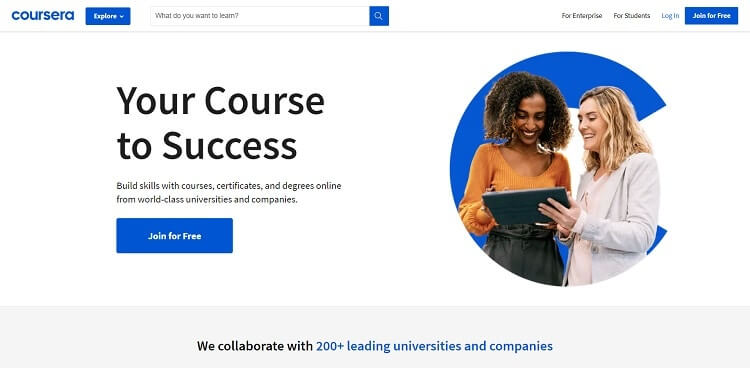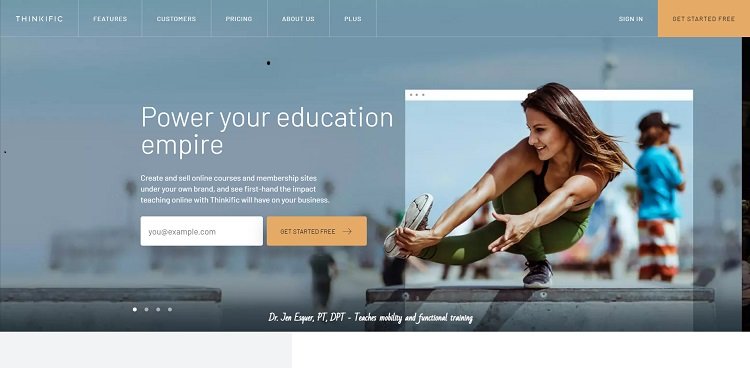How To Make An Online Course For Your Blog
One of the best ways to share your knowledge with the world and make money at the same time is by creating an online course.
Online learning is the new normal, and most businesses and educational institutions are investing in digital courses to keep up with changing trends. We can predict that the eLearning industry will be worth $300 billion within the next five years.
If you're wondering how to create an online course of your own and share it with the world, then keep reading. I'm going to give you a condensed, step-by-step guide on creating an online course this year.
Here, you'll get to know everything from
- Zeroing in on the right topic.
- Using authority in your chosen subject matter.
- Creating course content and choosing the right course platform.
- Using marketing channels that generate the highest revenue.
- And more…
Following these steps, you will learn how to create a plan for launching your first eLearning course with confidence.
Without further ado, let's get started with the guide.

Steps for How To Create An Online Course
Naturally, experts, entrepreneurs, and educators are taking the path of online course creation to share their knowledge. For students, online courses have become more popular which in my opinion has only made online education more mainstream.
The idea that my parents actually understand what an online course is and that they are used by universities only strengthens my belief in creating online courses.
There are several steps to be followed to launch a successful online course. From the actual course creation and pricing to marketing and beyond, here are the steps you need to make your course a big hit.
Table of Contents
1. Research And Settle On The Course Topic
Choosing the topic for your course is perhaps the most difficult but also the most critical step.
This is not something that you can take lightly at all. This will make or break the success of your course. If you create a course that doesn't solve a problem for a group of people online it will never do well.
Don't think of yourself as just a "course creator" you are a solutions provider that has real value to bring to the marketplace.
I suggest you begin market research tests with the following question:
What are the trending topics people are most interested in finding solutions for? Search engine optimization (SEO) tools like Ahrefs and Google Trends can help you understand the new and emerging subjects that most people are interested in.
Quick caveat on the above point… You have to actually provide a solution for the people. For example, it makes a lot of sense for me to create a blogging course, but for me to create a dog training course makes absolutely zero sense. Don't base your entire course on some random search data. It's a tool and use it as such.
You don't have to be an expert in the subject to create an online course; you just have to be ahead of your target audience.
Another aspect that you need to keep in mind here is that the possibilities are endless for creating online courses. From cooking courses to the basics of Jujitsu, you can create an online course on any topic under the sun.
However, a bit of personal advice here: always go for a topic you're passionate about (it also helps if you have formal training in it.) For example, you can create guitar tutorials even if you're an accountant, provided you have the know-how and passion for following through.
Of course, that doesn't mean you shouldn't create an online course on a topic you're an expert in! Selecting such a topic will make the course creation process and production phase simpler and more manageable. It'll also ensure that your students can derive professional-grade value from the course and actually get results from it.
2. Check Out The Market For The Topic
Along with searching for the topic for your course, you also need to keep an eye out for whether the subject you've chosen has enough popularity among your target audience. Most online course creators think that if the topic they have chosen already has many courses available, theirs might not sell. This is not necessarily true.
If there are a lot of courses about the topic that means that there is demand. Succeeding with selling courses comes down to finding where the demand is and supplying unique and better solutions.
To better understand the best online course ideas in your niche, you can check out major online learning platforms such as Udemy and Coursera. Scouring these sites will provide you with a good grasp of what most online learners and students are looking in your niche.
In short, in the first two steps, you need to find the sweet spot at the intersection of a topic you're passionate (or could become) about, have knowledge and expertise in, and which is also in demand. Once you've got all these boxes ticked, you can settle on that topic (or even topics) and move on to the next step.
3. Build Authority To Become An Expert
I'm sure you've noticed that in both the above steps, I've mentioned that you need to be knowledgeable about the subject you're creating a course on. At the same time, I've also said that you don't need to be an absolute expert to make your first online course.
These two statements might seem to be contradictory, but they are not.
While it's true that you should have some basic knowledge about the course subject you're about to teach, you can also pick up a lot as you go along.
There are two benefits to be gained from this:
First, you can get hold of a lot of learning objectives and material you can use in your course videos and study materials.
Second, you'll also get to build knowledge on specific niches in the topic that might make your online courses more profitable.
People don't only want to learn from the foremost expert on a topic. They want to learn from someone that they can relate to and trust.
Being an expert is great, but if you are relatable and willing to become an expert on the topic in order to serve your students; even better.
4. Settle On Your Target Audience
By now, I'm sure you have a clear idea about the topic you're going to create an online course about. Now it's time to understand your target audience, i.e., the demographic you're going to focus on serving.
It pays to be specific: not every topic is suited for every audience. Make sure that your target audience is well-defined and actionable and is interested in your subject of choice. The following are some of the demographic factors that you need to consider:
- Age of your target audience
- The Gender your course is more popular with
- The average Education Level of your target audience
- The Employment Status of your audience
The above list is not exhaustive and can vary based on your subject of choice. The average gender percentage for MOOC subscribers is 47% male and 53% female, and the average age for online students is 34.
Another factor that can decide your audience is seasonality. Some courses have more appeal at particular times, such as baking courses during the festive season.
You can also target audiences based on intent, for instance, aiming a data science course at the crowd looking to make a career transition to data science. An online course on interior design is another course idea.
Finally, don't forget to use social media to your advantage. Social channels such as Facebook groups, LinkedIn, and Instagram can be a fast way to identify a target audience for research. This is exactly what I did for my blogging course and it worked wonders for identifying the exact angle of the course.

5. Map Out The Online Course Outline
Anybody can create an online course and put it up for sale. However, creating an online course that actually gets results and is successful takes serious planning. It took me over 6 months to properly map out, test, and launch my blogging like a business course.
That's why, after you've settled on your target topic and audience, you need to create a detailed course outline. This is where you'll need to consider aspects such as how in-depth the course will be, what tone you're going to use to appeal to your target demographic, and learning objectives.
The course's depth will be primarily driven by your target audience's requirements. An online course on management principles aimed at post-grads will undoubtedly have to be more professional in style and depth than a cooking course which can be fun and quirky.
For how to create an online course outline, you can use several templates for online course creation that are available. Generally, breaking down your subject into specific topics, learning goals, and segmenting them further into targeted subtopics and lessons is an excellent place to start.
Remember that creating an outline is not mandatory. You can jump into creating the course content if you have a clear idea about what you want to impart to your learners. However, I suggest you don't skip this step, as it'll help you structure the modules and frame your course outcomes, which is the next topic I'll be discussing.
6. Frame Compelling Course Outcomes
Once you've completed your course outline and structured the modules, it's time to frame the course's ideal outcomes. Framing outcomes matters, students paid for the course to get results.
Just think about this. You know what material your course has and how it can help your students.
But they don't know about it, and unless your would-be learners can get a clear idea of what they can get out of the course, they'll be less likely to enroll.
That's why you need to create a course outline that can get your students results as fast as possible. Make sure you include these course outcomes on your course page prominently. Just so that learners have a concrete idea of what they're about to sign up for and their potential learning outcome.
Another benefit of creating customized course outcomes is that they ensure only interested students join the course. The right students translate to greater satisfaction and completion rates, along with lower requests for refunds.
7. Create The Actual Course Materials
After you've completed each of the above steps, it's finally time to jump in and create the actual course material. Here, you have a plethora of choices regarding the medium; I recommend going with video courses as these tend to have the most impact.
Along with the video, you also need to provide suitable study materials in the form of PowerPoint presentations, eBooks in PDF format, or self-assessment questionnaires. Each course will be different but the only goal to create additional materials that help your students get results.
The most common problem that online course creators face here is determining which materials to include in the course and which to leave out. No matter what topic you choose, you're sure to find multiple resources and references to use in today's age of information overload.
Here's where your online course outline and outcomes will guide you. When selecting materials for course creation, be sure that you include only those aligned with your course structure. Doing so will help you streamline the course content and also cut down on creation time.
Finally, once you have all the material at hand, it's time to record the videos. And here, you have a lot of flexibility; it doesn't take a pro videographer to create high-quality online courses. All you need is a good webcam and screen-capture software such as Camtasia.
Choose from screen-capture videos, talking head style videos, or even a combination of the two. In case you already have webinars or podcasts on the topic, don't hesitate to repurpose the content for your online course. All that matters is that you stay on topic and provide value.
8. Monetize It Right
Now that you've created the online course content, it's time to decide how you want to monetize. This can involve tactics such as offering a free course as a lead magnet or setting up a subscription-based model.
For premium courses, you'll have to perform some market research here as well. Check out the prices of similar courses on popular eLearning platforms, and understand what the enrolment rates are.
Another aspect you need to keep in mind is the purchasing power of your target audience. After all, there's no point in pricing a course so high that no one can buy it. Here, you'll have to strike the perfect balance between profitability and affordability.
One last thing when it comes to pricing: make sure your online course price matches the value you're providing. If you want to charge higher than the market rates, you'll need to provide better content than the competition; it's as simple as that.
9. Select The Appropriate Delivery Channel
After completing the above steps, you need to decide how you will deliver your course to your audiences. In general, there are three standard methods which you can sell online courses. Each of these is discussed below under separate heads.
A. Online Course Platforms
Online course platforms are one of the most popular methods of distributing your online courses. Platforms such as Coursera and Udemy are vibrant course marketplaces where you can sell your tutorials. These platforms provide a stable and integrated environment for course uploading, marketing, and selling.

In case you're uploading a course for the first time, you should take advantage of these platforms' goodwill and marketing reach. They make the process smooth, comfortable and even allow you to upload testimonials, worksheets and even customize your course content.
Here is my Thinkific review and why it is my #1 pick for online course platforms and is the one that I personally use.
B. Learning Management Systems (LMS)
An LMS is an online education system that can link to your website and work as a brand platform for your course. LMSs make everything from creating online courses to setting up a profitable online course business a simple process.
While there are many LMS options available on the market, my recommendation is Thinkific (Teachable is another excellent alternative). This online course platform lets you fully customize your courses and make every step from course subject or idea to creating and distribution a breeze.

C. Website Plugins
If you have your own website that you want to host the online course on, you can select from numerous website plugins available on the internet. WordPress provides the greatest flexibility for creating an online education membership site.
Whichever option you choose to go with, make sure you have the tools in place for enrolling and validating students. Also, don't forget to integrate your learning platform with payment gateways for easy enrollments and refunds if needed.
10. Build An Email List of Raving Fans
Most online course creators and startups make the mistake of thinking that they'll have a steady stream of income once their course is up and running. This is just not true; after you've created and uploaded your course, the real work begins.
You now need to market your online course, and there's no better way to do this than with email marketing. From experience, email marketing still provides the highest ROI among all digital product marketing channels.
In order to take advantage of email marketing, you need to create an email list of people to whom you can actually sell your course. I'd recommend running a social media marketing campaign to gather emails. You can even offer part of your online course for free as a bid to capture leads.
Once you've got a sizable email list, you need to send personalized, targeted emails to those learners who showed interest in your course. This way, you stand to ensure that they're able to leap prospects to paying customers.
11. Create A Sales Landing Page
However, don't think you're out of the woods yet, for just capturing emails is only half the battle won. Sending captivating emails is the best way to bring customers to your course landing page and website. Once they arrive there, however, you need to make sure that they have an incredible experience.
The best way to do this is to create a landing page that reflects your online course's essence. A high-quality landing page is the best way to ensure that learners get complete information about the course content.
When creating the landing page, you'll need to keep several factors in mind, such as the target demographic, your audience's interests, and even your subject.
Another good step is to create different landing pages for different audiences and test which works best. Such a split-testing model will give you a clear idea of organizing the layout of the page.
12. Jump On To The Marketing Bandwagon
Email lists, landing pages, and social media teasers are all parts of the bigger marketing plan you need to follow to succeed in your online course launch. An ongoing marketing strategy is essential to ensure that the word gets out about your online courses.
Here, you have several options to consider: you can run early bird campaigns that offer attractive discounts or even search engine or social media ads. What's more, you can also take advantage of content marketing strategies and promote your target list.
I'm sure you've already understood that the last three steps, including this one, were dedicated to marketing the courses. This extra emphasis on marketing is vital because the moment you stop marketing your course is when you effectively stop selling.
13. Nurture A Dedicated Community
At this stage, you've finally published your course.
But now, there's an even more critical part of the process to take care of: building a dedicated community of students.
One of the drawbacks of online courses is that they take away a lot of the direct interaction that comes in a classroom learning environment. However, you can easily overcome this using online channels such as a social media group and video conferencing webinars that allow you to interact with your students.
Learning is a social process, and people love to interact with other people who are on the same journey as them. Such interactions help to make the learning process more enjoyable and foster a sense of community around the course.
Another advantage of nurturing a dedicated community is that this helps to spread word-of-mouth publicity about your course. And when your customers become vocal advocates for your brand, your course will start to grow organically.
14. Remember To Update Your Course Over Time
The last point you need to focus on for how to create an online course: updating your course. Skill demands change over time and new skills need to be added to your course repertoire. You can't expect a three-year-old course to provide the same value to your students as it did at the time of launch.
Make sure you continuously keep on adding new course materials and update them according to market demands. That way, your online course remains relevant today and continues to provide value to your existing students.
Wrap Up
I hope this condensed guide has been able to help you in understanding the entire process of online course creation.
Not only will you be creating a steady income stream, but you will also have the advantage of sharing your expertise and emerging as a thought-leader in your niche. Now, that's better than any passive marketing strategy that money can buy.
Let me know your thoughts in the comments down below!
How To Make An Online Course For Your Blog
Source: https://www.adamenfroy.com/how-to-create-an-online-course
Posted by: barberdoweepastrou.blogspot.com

0 Response to "How To Make An Online Course For Your Blog"
Post a Comment